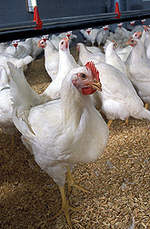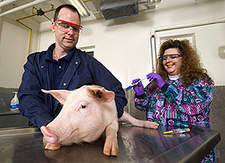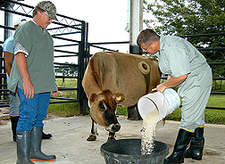



Subduing Salmonella, Several strategies seem promising
Illness caused by Salmonella isn’t usually fatal, but it can be very unpleasant. This intestinal pathogen, usually transmitted by raw or undercooked foods, can cause fever, abdominal cramps, and diarrhea. |
ARS scientists are investigating a variety of approaches to reducing consumer risk of Salmonella infection transmitted through foods of animal origin, including preharvest strategies.
Treating Feed
At the Food and Feed Safety Research Unit (FFSRU) in College Station, Texas, ARS researchers led by microbiologist Robin Anderson are mixing a chlorate-based compound into livestock feed or water 2 days before slaughter. When fed at roughly 0.5 to 5 percent of the animals’ diet, this powdery additive has proved very effective in reducing Salmonella and Escherichia coli O157:H7 in their gastrointestinal tracts. |
| After taking a fecal sample from a pig, microbiologists Bradley (left) and Shawn Bearson place the sample into a growth medium for detection of Salmonella. |
“With cattle,” says Anderson, “we went from 100,000 E. coli cells per gram of fecal material to 100 cells per gram. We observed a similar thousandfold reduction in numbers of Salmonella and E. coli bacteria in more than 100 swine and sheep we tested.”
Anderson developed the experimental chlorate product 5 years ago at the urging of the National Cattlemen’s Beef Association, which supports research on novel ways to reduce E. coli O157:H7, a virulent human pathogen. The swine research was supported with funding from the National Pork Board.
While working with Anderson on cattle tests, FFSRU microbiologist Allen Byrd also tested the chlorate compound in poultry. Byrd has evaluated more than 200 turkeys and 2,000 broiler chickens—giving the chlorate compound to market-age birds just before they went to processing. In turkeys, the incidence of Salmonella fell from 35 percent to zero; in broilers, it went from 37 percent to 2 percent in the 48 hours before slaughter. In studies by animal scientist Leon Kubena, the compound has shown good activity in preventing Salmonella shedding in molting hens.
The FFSRU scientists are involved in a cooperative research and development agreement with the Marietta, Georgia, branch of Akzo Nobel/Eka Chemicals, Inc., and ARS has patented the technology. Having tested the chlorate additive with collaborators at Texas A&M University under controlled environments, the researchers are awaiting approval from the Food and Drug Administration to test it on commercial farms.
 |
| Microbiologist Todd Callaway (right) and technician Jim Snodgrass mix in a sodium chlorate compound with this cow’s normal feed to test its effectiveness in reducing Salmonella and Escherichia coli 0157:H7 in the animal’s gastrointestinal tract. |
Molecular Tracking
Researchers in ARS’s Midwest Area are conducting research into host-pathogen interactions on a molecular level. Microbiologists Shawn Bearson in the Preharvest Food Safety and Enteric Diseases Unit, Bradley Bearson in the Swine Odor and Manure Management Research Unit, and Donald Lay, research leader of ARS’s Livestock Behavior Research Laboratory, are focusing on Salmonella infection in swine.After initial infection with Salmonella bacteria, pigs can enter a carrier state in which they no longer show clinical signs of infection and the pathogen is often undetectable. But, says Shawn Bearson, “Transportation and marketing activities can stress the animals, causing Salmonella to reemerge. The pathogen is then shed in the pigs’ manure, which can be a serious contamination issue on the farm and at the slaughter plant.”
The researchers have recently focused on swine’s release of the hormone norepinephrine (NE) during periods of stress.
“In DNA microarray studies performed in our laboratories, exposing S. Typhimurium to NE altered the expression of genes involved in many of its biochemical processes,” Bearson says. “We’ve also studied the growth-stimulating properties of NE on S. Typhimurium, and we’ve constructed gene-knockout mutants that are unable to respond to NE in lab tests.”
Bearson says these gene-knockout mutants of S. Typhimurium are being tested in a swine-infection model to determine whether they colonize the gastrointestinal tract of pigs less efficiently and are less pathogenic than wild-type strains. “Characterizing the molecular response of Salmonella to a host stress signal will help us devise strategies to control Salmonella shedding from carrier-state pigs during stressful situations,” she says.
 |
| Agricultural engineer Bailey Mitchell demonstrates an electrostatic air-cleaning system. The hatching cabinet used here is a small version of ones used commercially for hatching chicks. |
Peering Inside
At West Lafayette, Indiana, Lay is perfecting a harmless way to watch Salmonella bacteria move through live pigs. He’s working with Scott T. Willard of Mississippi State University, an expert in biophotonics. This new technology, used in biology and human medicine, uses light to mark molecular changes.Scientists don’t know how Salmonella bacteria migrate through an animal’s body, including where they hide and what causes them to be suddenly shed in manure. These knowledge gaps are largely due to an inability to follow the progression of infection in live animals.
Lay and Willard have shown that they can treat Salmonella bacteria so that they give off a low level of light. On a monitor connected to a photon-counting camera, the scientists can track the bacteria as they move through a piglet’s body. Next, they want to adapt the technique to see through the denser mass of live, 250-pound, market-ready pigs.
The researchers are testing various safe substances that might be brushed on adult pigs’ stomachs to make their skin more transparent. Using skin tissue in the laboratory, Lay and Willard have had success so far with glycerol, dimethyl sulfoxide, sugar, sucrose, and glucose—alone or in combination. A mix of 50 percent glycerol and 20 percent dimethyl sulfoxide doubled the depth through which the bacterial light could be seen.
So far, this biophotonic technique has been used mainly with small animals. With improvement, it could be used with larger ones to track other diseases. Lay and Willard will research ways to identify the pigs most susceptible to Salmonella infection and design techniques to prevent them from spreading it.
Bacteriocins Kill Pathogens
At the Poultry Microbiological Safety Research Unit in Athens, Georgia, ARS microbiologist Norman Stern and colleagues developed and patented a use for bacteriocins. These low-molecular-weight polypeptides kill other organisms within the intestinal tract. Though Stern has focused on Campylobacter, the bacteriocins were optimized and then tested on broiler chickens challenged and colonized with either Salmonella or Campylobacter.“This work has confirmed that bacteriocins can reduce Salmonella and Campylobacter to nearly undetectable levels in chicken intestines,” says Stern. “In turn, this reduces human exposure to the pathogens, which can potentially sicken those who eat undercooked or cross-contaminated food.” [See “International Partnership for Poultry Safety,” Agricultural Research, November 2005, pp. 9-11.]
Phages Enter a New Stage
Another innovative technique to control Salmonella and E. coli being investigated by FFSRU scientists is use of bacteriophages—viruses that kill targeted bacteria by taking over their intra-cellular machinery. Research has shown that phages can be used to kill bacteria that cause diseases in chickens, but they’ve not been used to control foodborne pathogens that don’t cause disease in the animals.In a collaborative project with Evergreen State College of Olympia, Washington, Anderson and FFSRU microbiologist Todd Callaway have isolated from feces of commercial feedlot cattle bacteriophages that kill E. coli and Salmonella. Studies conducted at FFSRU showed that these phages can be used to reduce intestinal populations of E. coli in sheep. Further research has isolated from feces of commercial swine bacteriophages that kill Salmonella. FFSRU studies are under way to determine their efficacy against Salmonella in swine. Several companies are interested in pursuing bacteriophages as a preharvest intervention strategy.
Cleansing the Environment
For a poultry grower, dust can be a disaster, because Salmonella that hitch a ride on airborne particles later wreak havoc in a poultry house or layer room.Engineer Bailey Mitchell, who recently retired from ARS’s Southeast Poultry Research Laboratory in Athens, developed a device to improve air quality. It places a strong electrostatic charge on airborne dust and microorganisms like Salmonella, which later collect on litter or on grounded room surfaces or collector plates.
In experimental and commercial hatching cabinets, the system reduced Salmonella and other airborne pathogens by 80 to 95 percent and eliminated airborne dust in other poultry areas by 50 to 95 percent. Studies also show a strong sterilizing effect on both airborne and surface Salmonella and other pathogenic bacteria. At close range, the kill rate on airborne and surface S. Enteritidis has been 95 percent or more.
Mitchell and colleagues have devised a portable, low-cost electrostatic sampler for high-efficiency sampling of airborne bacteria, viruses, and spores that are problematic in poultry houses and layer rooms.
The compact, 2-pound device is battery operated and housed in a waterproof enclosure that allows for disinfection after use. “It works like two magnets with opposite poles that are attracted to one another: It charges airborne particles, which are then attracted to a metal plate or an agar dish,” says Mitchell.
October 2006


